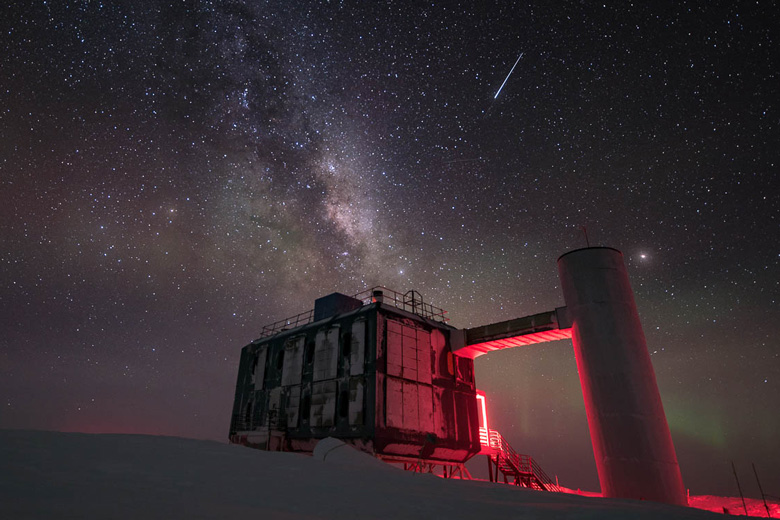Astroparticle Physics: Exploring the Universe Through High-Energy Particles
Astroparticle Physics: Exploring the Universe Through High-Energy Particles
Rayyan Abdullah
Astroparticle physics is a fascinating field that combines the study of particles and their interactions with the universe at large. It is a discipline that has seen rapid growth over the last few decades, and it promises to unlock some of the biggest mysteries in the universe. In this article, we will delve into the world of astroparticle physics, exploring its origins, key concepts, and the exciting discoveries that have been made in recent years.
 |
| Credit - Uppsala University, Sweden |
Astroparticle physics is a relatively new field that emerged in the 1990s. Its origins can be traced back to the discovery of cosmic rays in the early 20th century. These are high-energy particles that originate from outside the solar system and are constantly bombarding the Earth. They were first detected in 1912 by Austrian physicist Victor Hess, who carried out a series of balloon flights to measure the ionizing radiation at different altitudes. His findings showed that the level of ionization increased with altitude, suggesting that there was a source of radiation in space.
  Austrian physicist Victor Hess (Left) - Source (Wikipedia) Picture of Victor Hess taking balloon flight (Right) |
The study of cosmic rays led to the development of particle accelerators, which allowed physicists to recreate the high-energy conditions of the early universe in a laboratory. This paved the way for the discovery of new particles, such as the Higgs boson, which was first observed in 2012 at the Large Hadron Collider (LHC) in Geneva, Switzerland. However, while particle accelerators have been instrumental in advancing our understanding of particle physics, they are limited in their ability to study particles with energies beyond a certain threshold.
 |
| Large Hadron Collider at CERN, Switzerland - Source: CERN |
Astroparticle physics seeks to overcome this limitation by studying the particles that are produced by the cosmos itself. This includes cosmic rays, neutrinos, and gamma rays, among others. These particles are produced by some of the most violent and energetic events in the universe, such as supernovae, black holes, and gamma-ray bursts. By studying these particles, astroparticle physicists hope to gain insight into the workings of the universe at its most fundamental level.
One of the key concepts in astroparticle physics is the idea of dark matter. Dark matter is a hypothetical form of matter that is thought to make up around 85% of the total matter in the universe. It does not interact with light or any other form of electromagnetic radiation, which makes it very difficult to detect. However, its presence can be inferred from the gravitational effects it has on visible matter, such as galaxies and galaxy clusters.
 |
| Dark Matter makes up about 26 % and Dark Energy about 69 % of the universe, and only 5% regular matter- Credit- UCR/Mohamed Abdullah |
Another important concept in astroparticle physics is the study of neutrinos. Neutrinos are subatomic particles that are produced by nuclear reactions in the Sun, as well as by cosmic ray interactions with the Earth's atmosphere. They are very difficult to detect because they rarely interact with other matter. However, they can be detected using specialized detectors, such as the Super-Kamiokande detector in Japan.
In recent years, astroparticle physics has seen some exciting discoveries. In 2017, the IceCube Neutrino Observatory in Antarctica detected a high-energy neutrino that was traced back to a blazar, a type of active galactic nucleus. This was the first time that a neutrino had been traced back to a specific source, and it opened up a new era in neutrino astronomy.
 |
| IceCube Observatory at the South Pole Credit - IceCube |
In 2019, the Event Horizon Telescope (EHT) captured the first-ever image of a black hole. This was a monumental achievement that required the collaboration of over 200 scientists from around the world. The image showed the shadow of the black hole at the center of the Messier 87 galaxy, and it confirmed some of the predictions of Einstein's theory of general relativity.
 |
| Black Hole Image by Event Horizon Telescope Credits: Event Horizon Telescope collaboration |
Astroparticle physics is a rapidly evolving field that promises to unlock some of the biggest mysteries in the universe. From the study of cosmic rays to the detection of high-energy neutrinos and the observation of gravitational waves, astroparticle physicists are at the forefront of uncovering the secrets of the cosmos. They use advanced technology and mathematical models to investigate the behavior of subatomic particles and their interactions with the universe at large. By studying these phenomena, astroparticle physicists seek to answer fundamental questions about the nature of matter, the origin of the universe, and the forces that govern the cosmos. With each new discovery, they bring us closer to a more complete understanding of the universe we live in.
Comments
Post a Comment